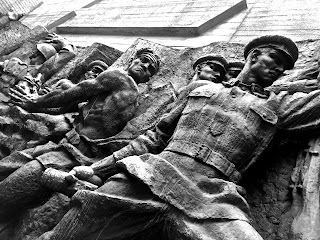Гiсторыя майка жыцця (Story of My Life) (2017)
KYIV DESTINATION: The War Museum



As neighbours Ukraine and Belarus were both part of the Soviet Union during the 1930s and both were severely affected by the second world war. The two countries have a shared history dating back to the 9th century, but WWII had a devastating impact on them both. Under the Soviet Union the capital cities Kyiv and Minsk were both made "hero cities" to mark the sacrifices that they made.


Belarus and Ukraine were both occupied by Germany, had Nazi administrations for three years and were made provinces of the Thrid Reich. Estimates vary but Belarus lost 2 million people - or 25% of its population; Ukraine lost 6.5 million people - or 16% of its population. By comparison Russia lost 13.5 million people, or 12.5% of its population.
You can still experience WWII at the War Museum http://www.warmuseum.kiev.ua. This vast complex is schizophrenic in that it is partially frozen in time and partially very actual. That's because it houses a Soviet display of WWII and very contemporary exhibitions about the fighting in the East with pro-Russian forces.
In both Belarus and Ukraine that process has started. Mention is made of how the Soviets also destroyed buildings during battle - and not just the Germans and their allies.
WWII in Belarus and Ukraine
EUROVISION COUNTRY: BelarusKYIV DESTINATION: The War Museum



As neighbours Ukraine and Belarus were both part of the Soviet Union during the 1930s and both were severely affected by the second world war. The two countries have a shared history dating back to the 9th century, but WWII had a devastating impact on them both. Under the Soviet Union the capital cities Kyiv and Minsk were both made "hero cities" to mark the sacrifices that they made.


Belarus and Ukraine were both occupied by Germany, had Nazi administrations for three years and were made provinces of the Thrid Reich. Estimates vary but Belarus lost 2 million people - or 25% of its population; Ukraine lost 6.5 million people - or 16% of its population. By comparison Russia lost 13.5 million people, or 12.5% of its population.
You can still experience WWII at the War Museum http://www.warmuseum.kiev.ua. This vast complex is schizophrenic in that it is partially frozen in time and partially very actual. That's because it houses a Soviet display of WWII and very contemporary exhibitions about the fighting in the East with pro-Russian forces.
This museum complex is situated next to the Lavra monastery complex, along the cliffs looking down on the Dnipro river. It includes and culminates in the gargantuan titanium-clad Mother of the Motherland statue, which houses half of the indoor exhibits.
The museum clearly deals with the war in Ukraine, but many text and picture references are focussed on the Soviet Union. However one final room has been turned into an art installation that reflects more Ukrainian interpretations of the loss (rather than the glory of war). It successfully uses a folk tradition of leaving out a spare setting at the dinner table for absent family members. The room has a massive table with hundreds of settings and artefacts of the war, while the walls are covered with thousands of contemporary photographs of people who died during that period.
The full story of WWII has still to be reinterpreted. This will require time of keeping fact and unravelling Soviet myth.In both Belarus and Ukraine that process has started. Mention is made of how the Soviets also destroyed buildings during battle - and not just the Germans and their allies.
Also the symbolism of remembering the dead has changed in the last two years. While Russians still remember wars with images of veterans wearing medals, both Ukraine and Bearus have opted for a more Western symbolism. Ukraine for the last two years has used the smbol of the red poppy, which people in the UK consider (incorrectly) to be a universal symbol. Belarus has opted for an apple blossom sprig.
While Russia still commemorates 23rd February as Army (and hence Father's) Day - both countries have also dropped official recognition.
Belarusian embassy:
Address: 3, Mykhailia Kotsyubynskoho St, 01030 Kyiv
Tel: +380 44 537 5200
Website: http://ukraine.mfa.gov.by/ru/
What other Belarusian links are there in Kyiv?














Comments
Post a Comment